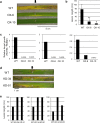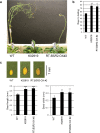The rice CYP78A gene BSR2 confers resistance to Rhizoctonia solani and affects seed size and growth in Arabidopsis and rice
- PMID: 30679785
- PMCID: PMC6345848
- DOI: 10.1038/s41598-018-37365-1
The rice CYP78A gene BSR2 confers resistance to Rhizoctonia solani and affects seed size and growth in Arabidopsis and rice
Abstract
The fungal pathogen Rhizoctonia solani causes devastating diseases in hundreds of plant species. Among these, R. solani causes sheath blight, one of the three major diseases in rice. To date, few genes have been reported that confer resistance to R. solani. Here, rice-FOX Arabidopsis lines identified as having resistance to a bacterial pathogen, Pseudomonas syringae pv. tomato DC3000, and a fungal pathogen, Colletotrichum higginsianum were screened for disease resistance to R. solani. BROAD-SPECTRUM RESISTANCE2 (BSR2), a gene encoding an uncharacterized cytochrome P450 protein belonging to the CYP78A family, conferred resistance to R. solani in Arabidopsis. When overexpressed in rice, BSR2 also conferred resistance to two R. solani anastomosis groups. Both Arabidopsis and rice plants overexpressing BSR2 had slower growth and produced longer seeds than wild-type control plants. In contrast, BSR2-knockdown rice plants were more susceptible to R. solani and displayed faster growth and shorter seeds in comparison with the control. These results indicate that BSR2 is associated with disease resistance, growth rate and seed size in rice and suggest that its function is evolutionarily conserved in both monocot rice and dicot Arabidopsis.
Conflict of interest statement
K.O., M.M.a., H.H. and M.M.o. were funded by Japan Science and Technology Agency. M.M.o. was funded by the Ministry of Agriculture, Forestry, and Fisheries of Japan and has been funded by NARO Bio-oriented Technology Research Advancement Institution. S.M., J.G.D., Y.K., Y.J. and S.S. declare no potential conflict of interest.
Figures







Similar articles
-
Enhanced resistance to fungal and bacterial diseases in tomato and Arabidopsis expressing BSR2 from rice.Plant Cell Rep. 2020 Nov;39(11):1493-1503. doi: 10.1007/s00299-020-02578-0. Epub 2020 Aug 9. Plant Cell Rep. 2020. PMID: 32772129
-
Overexpression of a Monocot Acyl-CoA-Binding Protein Confers Broad-Spectrum Pathogen Protection in a Dicot.Proteomics. 2019 Jun;19(12):e1800368. doi: 10.1002/pmic.201800368. Proteomics. 2019. PMID: 31054181
-
The overexpression of OsACBP5 protects transgenic rice against necrotrophic, hemibiotrophic and biotrophic pathogens.Sci Rep. 2020 Sep 10;10(1):14918. doi: 10.1038/s41598-020-71851-9. Sci Rep. 2020. PMID: 32913218 Free PMC article.
-
Understanding sheath blight resistance in rice: the road behind and the road ahead.Plant Biotechnol J. 2020 Apr;18(4):895-915. doi: 10.1111/pbi.13312. Epub 2020 Jan 29. Plant Biotechnol J. 2020. PMID: 31811745 Free PMC article. Review.
-
Sheath blight of rice: a review and identification of priorities for future research.Planta. 2019 Nov;250(5):1387-1407. doi: 10.1007/s00425-019-03246-8. Epub 2019 Jul 25. Planta. 2019. PMID: 31346804 Review.
Cited by
-
Differential expression of SlKLUH controlling fruit and seed weight is associated with changes in lipid metabolism and photosynthesis-related genes.J Exp Bot. 2021 Feb 24;72(4):1225-1244. doi: 10.1093/jxb/eraa518. J Exp Bot. 2021. PMID: 33159787 Free PMC article.
-
Purinoceptor P2K1/DORN1 Enhances Plant Resistance Against a Soilborne Fungal Pathogen, Rhizoctonia solani.Front Plant Sci. 2020 Sep 25;11:572920. doi: 10.3389/fpls.2020.572920. eCollection 2020. Front Plant Sci. 2020. PMID: 33101341 Free PMC article.
-
The OsZHD1 and OsZHD2, Two Zinc Finger Homeobox Transcription Factor, Redundantly Control Grain Size by Influencing Cell Proliferation in Rice.Rice (N Y). 2025 Mar 22;18(1):20. doi: 10.1186/s12284-025-00774-8. Rice (N Y). 2025. PMID: 40119214 Free PMC article.
-
Loose Plant Architecture 1-Interacting Kinesin-like Protein KLP Promotes Rice Resistance to Sheath Blight Disease.Rice (N Y). 2021 Jul 2;14(1):60. doi: 10.1186/s12284-021-00505-9. Rice (N Y). 2021. PMID: 34215911 Free PMC article.
-
ONAC066, A Stress-Responsive NAC Transcription Activator, Positively Contributes to Rice Immunity Against Magnaprothe oryzae Through Modulating Expression of OsWRKY62 and Three Cytochrome P450 Genes.Front Plant Sci. 2021 Sep 9;12:749186. doi: 10.3389/fpls.2021.749186. eCollection 2021. Front Plant Sci. 2021. PMID: 34567053 Free PMC article.
References
-
- Budge GE, Shaw MW, Colyer A, Pietravalle S, Boonham N. Molecular tools to investigate Rhizoctonia solani distribution in soil. Plant Pathol. 2009;58:1071–1080. doi: 10.1111/j.1365-3059.2009.02139.x. - DOI
-
- Yang, G. & Li, C. General Description of Rhizoctonia Species Complex. Plant Pathology 41–52 (2012).
Publication types
MeSH terms
Substances
LinkOut - more resources
Full Text Sources
Other Literature Sources
Molecular Biology Databases

